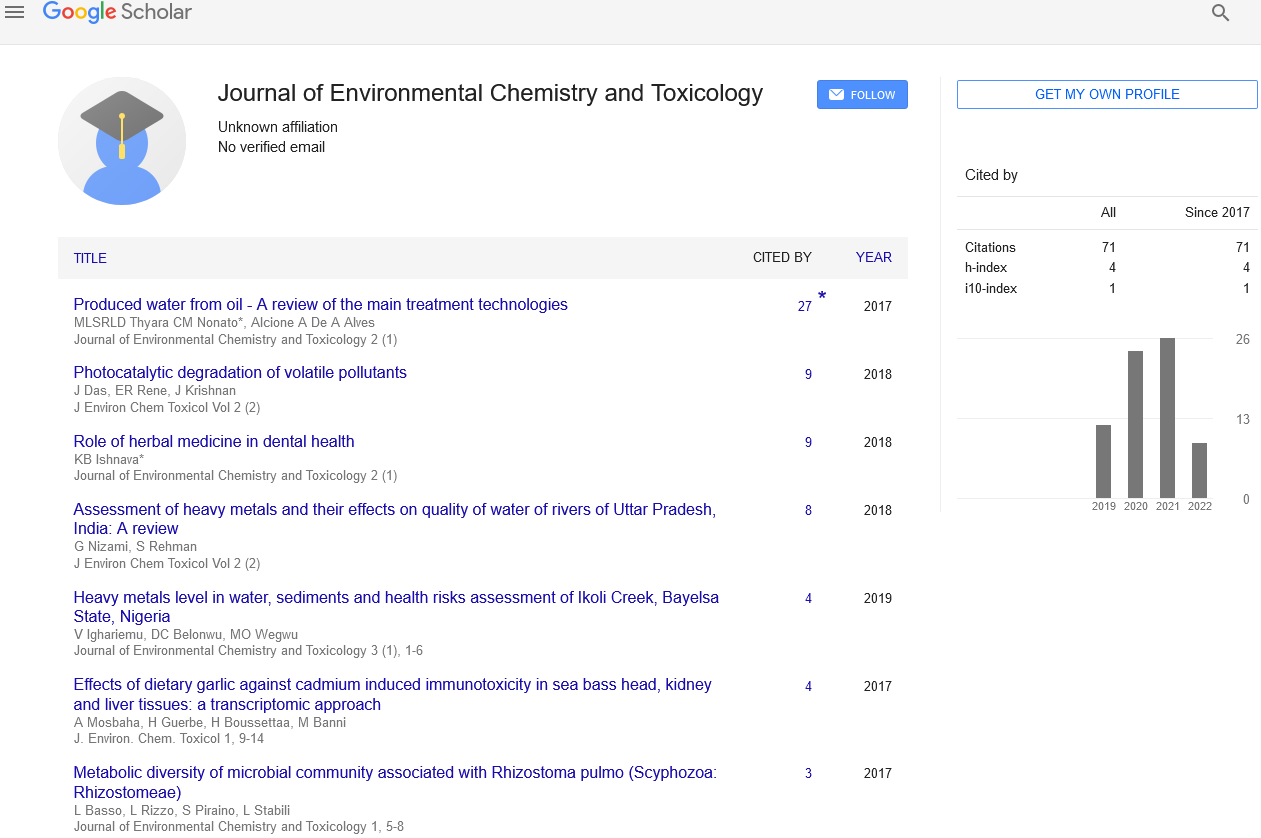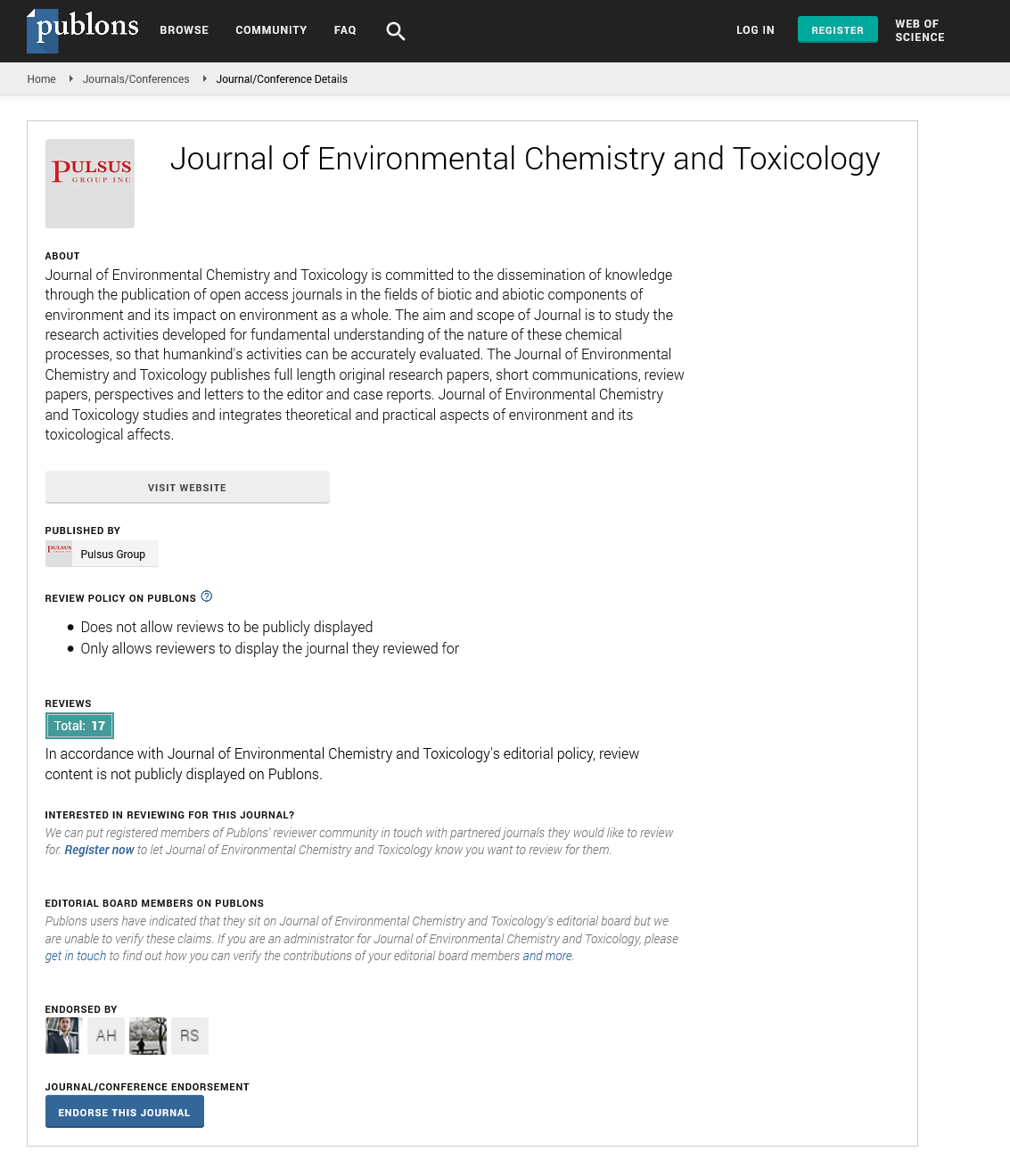The crustacean gill has numerous roles, including osmotic/ionic control, acid-base balance, ammonia excretion, and bioaccumulation of hazardous metals
Received: 04-Dec-2022, Manuscript No. PULJECT-22-5810; Editor assigned: 06-Dec-2022, Pre QC No. PULJECT-22-5810 (PQ); Reviewed: 20-Dec-2022 QC No. PULJECT-22-5810; Revised: 20-Feb-2023, Manuscript No. PULJECT-22-5810 (R); Published: 27-Feb-2023, DOI: 10.37532/ pulject.2023.7(1)-01-02.
Citation: James V. The crustacean gill has numerous roles, including osmotic/ionic control, acid-base balance, ammonia excretion, and bioaccumulation of hazardous metals. J Environ Chem Toxicol 2023; 7(1):1-2.
This open-access article is distributed under the terms of the Creative Commons Attribution Non-Commercial License (CC BY-NC) (http://creativecommons.org/licenses/by-nc/4.0/), which permits reuse, distribution and reproduction of the article, provided that the original work is properly cited and the reuse is restricted to noncommercial purposes. For commercial reuse, contact reprints@pulsus.com
Abstract
Ion transport, which forms the basis for hemolymph osmoregulation, acid-base balance, and ammonia excretion are just a few of the physiological activities that take place in the multifunctional organ known as the crustacean gill. The gill plays a significant role in the toxicology of these species since it is the place where many hazardous metals are ingested by aquatic crustaceans. This article offers a thorough understanding of the ecology, physiology, biochemistry, and molecular biology of the gill's mechanisms for controlling osmotic and ionic balance. The history of their creation is examined, along with the current theories regarding the mechanics of ion transport and the structural, biochemical, and molecular underpinnings of systemic physiology. The connection between hemolymphic acid-base control and branchial ion transport.
Keywords
Thermal waters; Sulfurous; Obstructive pulmonary; Physiology; Biochemistry
Introduction
AOver the past 100 years, significant conceptual andtechnological advancements have been made in the study of osmoregulation in crustaceans, and fundamental core ideas have also been reaffirmed. It has been demonstrated that the crustacean gill, which is involved in osmoregulation, is crucial for numerous other physiological and biochemical processes. The estuarine environment, which is already challenging due to fluctuations in naturally occurring physical parameters, is rendered much more challenging since it frequently serves as the accumulation location for harmful substances generated by humans, such as heavy metals. The goal of this review is to thoroughly discuss the subject of various gill functions, from an ecological perspective to the level of the genome. Our intention is to accomplish combining traditional ideas from the foundational literature with current discoveries in physiology, molecular biology, and genomic biology, this collection brings together a large corpus of material. In addition to discussing the gill's functions in a reductionist, mechanistic framework, this review also makes an effort to incorporate these processes into the complex ways in which the gill works both inside the body of the organism and beyond it.
From 35 to almost 0 ppt (1050 to nearly 0 mOsm kg H2O), euryhaline marine invertebrates can withstand significant changes in the salinity of their environment. These species have been able to infiltrate and take advantage of the estuary environment because they have developed the ability to survive in low and changing salinity. Estuaries are generally thought of as bodies of water where salt and fresh water from oceans or bays combined.
Description
Early in the 20th century, it became evident that in hyperosmoregulating Crustacea, the primary location of active NaCl absorption is the gills. The majority of species that move between seawater and various coastal settings such lagoons, intertidal zones, and estuaries and, eventually, the freshwater of rivers and lakes have been examined for their transbranchial processes of NaCl absorption. Large crustaceans, like crabs, crayfish, and lobsters, have been used in the majority of research on transbranchial NaCl absorption. Since these creatures' larger gills make it easier to investigate transepithelial ion transport, it can be hypothesised that smaller crustaceans have evolved comparable, if not identical, systems. Numerous methods have been used to study NaCl uptake across the gills of hyperosmoregulating crustaceans, including several types of microscopic inspection and biochemical and molecular investigations. This section of the current review summarizes the findings from experiments on transepithelial transport using split gill lamellae and epipodites mounted in using type chambers, isolated and perfused gills, and perfused and isolated gills.
Intracellular osmoregulation, also known as cell volume regulation, appears to be a trait shared by all marine crustaceans (see also "Introduction"). As a result, when these creatures migrate between seawater and moderately diluted brackish waters, their extracellular body fluid is able to withstand only minor alterations. Osmoconforming crabs' gill cuticles exhibit a higher conductivity than those of hyperosmoregulators. In a Ussing-chamber, hemiepipodites of the marine, osmoconforming spiny lobster Palinurus elephas displayed extremely high transbranchial conductances (Gte) of above 200 mS cm2 and a very low short-circuit current (Isc). After the mice were transferred to a diluted medium, neither Isc nor Gte shown a discernible change. Another illustration is Cancer pagurus, which was determined to have a conductivity of 250 ms cm2. In Ussing-chamber studies of split gill lamellae of osmoconforming Chinese crabs (E. sinensis) acclimated to seawater, the preparations did not demonstrate active transport, and the transepithelial conductance was not measured.
Conclusion
In conclusion, in diluted ambient fluids, hyperosmoregulators with high conductance gill epithelia experience substantial losses of NaCl. These animals' gill epithelia produce high rates of active NaCl absorption at comparatively modest transepithelial voltages. The active NaCl uptake mechanisms are similar to other well-studied, high conductance epithelia, such as the proximal tubule and the thick ascending limb of the mammalian kidney's Henle's loop.






